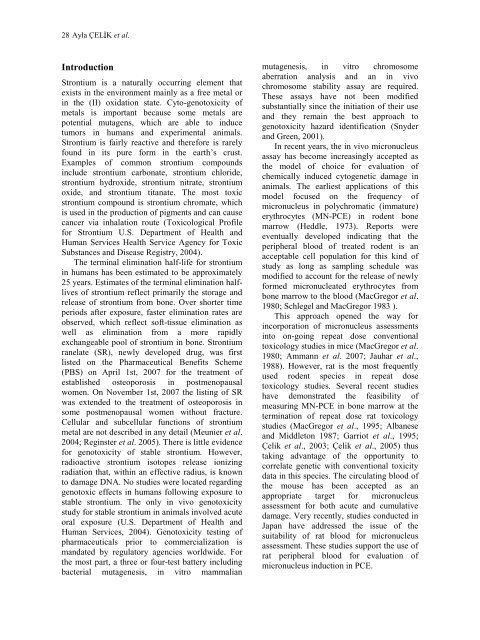Journal of Cell and Molecular Biology - ResearchGate
Journal of Cell and Molecular Biology - ResearchGate
Journal of Cell and Molecular Biology - ResearchGate
Create successful ePaper yourself
Turn your PDF publications into a flip-book with our unique Google optimized e-Paper software.
28 Ayla ÇELİK et al.<br />
Introduction<br />
Strontium is a naturally occurring element that<br />
exists in the environment mainly as a free metal or<br />
in the (II) oxidation state. Cyto-genotoxicity <strong>of</strong><br />
metals is important because some metals are<br />
potential mutagens, which are able to induce<br />
tumors in humans <strong>and</strong> experimental animals.<br />
Strontium is fairly reactive <strong>and</strong> therefore is rarely<br />
found in its pure form in the earth’s crust.<br />
Examples <strong>of</strong> common strontium compounds<br />
include strontium carbonate, strontium chloride,<br />
strontium hydroxide, strontium nitrate, strontium<br />
oxide, <strong>and</strong> strontium titanate. The most toxic<br />
strontium compound is strontium chromate, which<br />
is used in the production <strong>of</strong> pigments <strong>and</strong> can cause<br />
cancer via inhalation route (Toxicological Pr<strong>of</strong>ile<br />
for Strontium U.S. Department <strong>of</strong> Health <strong>and</strong><br />
Human Services Health Service Agency for Toxic<br />
Substances <strong>and</strong> Disease Registry, 2004).<br />
The terminal elimination half-life for strontium<br />
in humans has been estimated to be approximately<br />
25 years. Estimates <strong>of</strong> the terminal elimination halflives<br />
<strong>of</strong> strontium reflect primarily the storage <strong>and</strong><br />
release <strong>of</strong> strontium from bone. Over shorter time<br />
periods after exposure, faster elimination rates are<br />
observed, which reflect s<strong>of</strong>t-tissue elimination as<br />
well as elimination from a more rapidly<br />
exchangeable pool <strong>of</strong> strontium in bone. Strontium<br />
ranelate (SR), newly developed drug, was first<br />
listed on the Pharmaceutical Benefits Scheme<br />
(PBS) on April 1st, 2007 for the treatment <strong>of</strong><br />
established osteoporosis in postmenopausal<br />
women. On November 1st, 2007 the listing <strong>of</strong> SR<br />
was extended to the treatment <strong>of</strong> osteoporosis in<br />
some postmenopausal women without fracture.<br />
<strong>Cell</strong>ular <strong>and</strong> subcellular functions <strong>of</strong> strontium<br />
metal are not described in any detail (Meunier et al.<br />
2004; Reginster et al. 2005). There is little evidence<br />
for genotoxicity <strong>of</strong> stable strontium. However,<br />
radioactive strontium isotopes release ionizing<br />
radiation that, within an effective radius, is known<br />
to damage DNA. No studies were located regarding<br />
genotoxic effects in humans following exposure to<br />
stable strontium. The only in vivo genotoxicity<br />
study for stable strontium in animals involved acute<br />
oral exposure (U.S. Department <strong>of</strong> Health <strong>and</strong><br />
Human Services, 2004). Genotoxicity testing <strong>of</strong><br />
pharmaceuticals prior to commercialization is<br />
m<strong>and</strong>ated by regulatory agencies worldwide. For<br />
the most part, a three or four-test battery including<br />
bacterial mutagenesis, in vitro mammalian<br />
mutagenesis, in vitro chromosome<br />
aberration analysis <strong>and</strong> an in vivo<br />
chromosome stability assay are required.<br />
These assays have not been modified<br />
substantially since the initiation <strong>of</strong> their use<br />
<strong>and</strong> they remain the best approach to<br />
genotoxicity hazard identification (Snyder<br />
<strong>and</strong> Green, 2001).<br />
In recent years, the in vivo micronucleus<br />
assay has become increasingly accepted as<br />
the model <strong>of</strong> choice for evaluation <strong>of</strong><br />
chemically induced cytogenetic damage in<br />
animals. The earliest applications <strong>of</strong> this<br />
model focused on the frequency <strong>of</strong><br />
micronucleus in polychromatic (immature)<br />
erythrocytes (MN-PCE) in rodent bone<br />
marrow (Heddle, 1973). Reports were<br />
eventually developed indicating that the<br />
peripheral blood <strong>of</strong> treated rodent is an<br />
acceptable cell population for this kind <strong>of</strong><br />
study as long as sampling schedule was<br />
modified to account for the release <strong>of</strong> newly<br />
formed micronucleated erythrocytes from<br />
bone marrow to the blood (MacGregor et al.<br />
1980; Schlegel <strong>and</strong> MacGregor 1983 ).<br />
This approach opened the way for<br />
incorporation <strong>of</strong> micronucleus assessments<br />
into on-going repeat dose conventional<br />
toxicology studies in mice (MacGregor et al.<br />
1980; Ammann et al. 2007; Jauhar et al.,<br />
1988). However, rat is the most frequently<br />
used rodent species in repeat dose<br />
toxicology studies. Several recent studies<br />
have demonstrated the feasibility <strong>of</strong><br />
measuring MN-PCE in bone marrow at the<br />
termination <strong>of</strong> repeat dose rat toxicology<br />
studies (MacGregor et al., 1995; Albanese<br />
<strong>and</strong> Middleton 1987; Garriot et al., 1995;<br />
Çelik et al., 2003; Çelik et al., 2005) thus<br />
taking advantage <strong>of</strong> the opportunity to<br />
correlate genetic with conventional toxicity<br />
data in this species. The circulating blood <strong>of</strong><br />
the mouse has been accepted as an<br />
appropriate target for micronucleus<br />
assessment for both acute <strong>and</strong> cumulative<br />
damage. Very recently, studies conducted in<br />
Japan have addressed the issue <strong>of</strong> the<br />
suitability <strong>of</strong> rat blood for micronucleus<br />
assessment. These studies support the use <strong>of</strong><br />
rat peripheral blood for evaluation <strong>of</strong><br />
micronucleus induction in PCE.

















